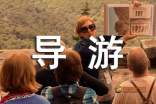长城英文导游词
作为一名尽职尽责的导游,常常需要准备导游词,导游词是导游员同游客交流思想,向游客传播文化知识的讲解词。如何把导游词做到重点突出呢?以下是小编为大家整理的长城英文导游词,欢迎阅读与收藏。

长城英文导游词1
In the north of China, there lies a 6,700-kilometer-long (4,161-mile-long)ancient wall. Now well-known as the Great Wall of China, it starts at theJiayuguan Paof Gansu Province in the west and ends at the Shanhaiguan Paof HebeiProvince in the east. As one of the Eight Wonders in the world, the Great Wallof China has become the symbol of the Chinese nation and its culture.
Lots of beautiful legends and stories about the Great Wall took placefollowing along the construction, and since that time these stories have spreadaround the country. Those that happened during construction are abundant, suchas Meng Jiangnu‘s story and the legend of the Jiayuguan Pass. Meng Jiangnu‘sstory is the most famous and widely spread of all the legends about the GreatWall. The story happened during the Qin Dynasty (221BC-206BC). It tells of howMeng Jiangnu‘s bitter weeping made a section of the Great Wall collapse. MengJiangnu‘s husband Fan Qiliang was caught by federal officials and sent to buildthe Great Wall. Meng Jiangnu heard nothing from him after his departure, so sheset out to look for him. Unfortunately, by the time she reached the great wall,she discovered that her husband had already died. Hearing the bad news, shecried her heart out. Her howl caused the collapse of a part of the Great Wall.This story indicates that the Great Wall is the production of tens of thousandsof Chinese commoners.
htmlAnother legend about the Jiayuguan Patells of a workman named YiKaizhan in the Ming Dynasty (1368BC-1644BC) who was proficient in arithmetic. Hecalculated that it would need 99,999 bricks to build the Jiayuguan Pass. Thesupervisor did not believe him and said if they miscalculated by even one brick,then all the workmen would be punished to do hard work for three years. Afterthe completion of the project, one brick was left behind the Xiwong city gate.The supervisor was happy at the sight of the brick and ready to punish them.However Yi Kaizhan said with deliberation that the brick was put there by asupernatural being to fix the wall. A tiny move would cause the collapse of thewall. Therefore the brick was kept there and never moved. It can still be foundthere today on the tower of the Jiayuguan Pass.
In addition to the above-mentioned stories about the construction of theGreat Wall, there are also plenty of stories about current scenic spots. Afamous one is the legend of the Beacon Tower. This story happened during theWestern Zhou Dynasty (11th century BC-711 BC). King You had a queen named BaoSi, who was very pretty. King You liked her very much, however Bao Si neversmiled. An official gave a suggestion that setting the beacon tower on firewould frighten the King‘s subjects, and might make the queen smile. King Youliked the idea. The subjects were fooled and Bao Si smiled at the sight of thechaos. Later enemies invaded Western Zhou, King You set the beacon tower on fireto ask for help. No subjects came to help because they had been fooled oncebefore. Thus, King Zhou was killed by the enemy and Western Zhou came to anend.
Beautiful stories and legends about the Great Wall help to keep aliveChinese history and culture. In each dynasty after the building of the GreatWall, many more stories were created and spread.
长城英文导游词2
Everybody is good! My name is zhang, you can call me a guide. Today I bringyou to visit verve magnificent Great Wall.
MAO zedong once said: "not a true man unless he comes to the Great Wall".Why don't we go on a tour today? Good! We can eat when men now! On the formersee head, after the end of the Great Wall.
About the Great Wall, there is a moving story, legend meng jiangnu'shusband was caught to build the Great Wall, the meng jiangnu then struggling tofind her husband, however, meng jiangnu I get to know and her husband were deadtired at the foot of the Great Wall. After hearing the news, meng jiangnu cryfor three days and three nights at the foot of the Great Wall, just listen to"bang" a loud walls down, to see the bodies of her husband!
Now that we have stood on the badaling, stepping at the foot of the squarebrick, holding the stone on the wall, naturally think of the Great Wall isbuilt. Tourists, look at these countless stone alone, with 2 - one thousandcatties a enough at that time, there was also no crane, crane, forklift, rely onthe shoulder, countless hands, step by step, carry on the steep mountains.
Well, the beauty of the Great Wall I said also said not over, now pleaseenjoy the beautiful scenery of the Great Wall!
长城英文导游词3
The Great Wall, like the Pyramids of Egypt, the Taj Mahal(1) in India andthe Hanging Garden of Babylon(2), is one of the great wonders of the world.Starting out in the east on the banks of the Yalu River in Liaoning Province,the Wall stretches westwards for 12,700 kilometers to Jiayuguan in the Gobidesert, thus known as the Ten Thousand Li Wall in China. The Wall climbs up anddown, twists and turns along the ridges of the Yanshan and Yinshan MountainChains through five provinces-Liaoning, Hebei, Shanxi, Shaanxi, and Gansu--andtwo autonomous regions--Ningxia and Inner Mongolia, binding the northern Chinatogether.
Historical records trace the construction of the origin of the Wall todefensive fortification back to the year 656 B.C. during the reign of King Chengof the States of Chu. Its construction continued throughout the Warring Statesperiod in the fifth Century B.C. when ducal states Yan, Zhao, Wei, and Qin werefrequently plundered by the nomadic peoples living north of the Yinshan andYanshan mountain ranges. Walls, then, were built separately by these ducalstates to ward off such harassments. Later in 221 B.C., when Qin conquered theother states and unified China, Emperor Qinshihuang ordered the connection ofthese individual walls and further extensions to form the basis of the presentgreat wall. As a matter of fact, a separate outer wall was constructed north ofthe Yinshan range in the Han Dynasty(206 BC--1644 BC.), which went to ruinthrough years of neglect. In the many intervening centuries, succeedingdynasties rebuilt parts of the Wall. The most extensive reinforcements andrenovations were carried out in the Ming Dynasty (1368--1644) when altogether 18lengthy stretches were reinforced with bricks and rocks. it is mostly the MingDynasty Wall that visitors see today. The Great Wall is divided into twosections, the east and west, with Shanxi Province as the dividing line. The westpart is a rammed earth construction, about 5.3 meters high on average. In theeastern part, the core of the Wall is rammed earth as well, but the outer shellis reinforced with bricks and rocks. The most imposing and best preservedsections of the Great Wall are at Badaling and Mutianyu, not far from Beijingand both are open to visitors. The Wall of those sections is 7.8 meters high and6.5 meters wide at its base, narrowing to 5.8 meters on the ramparts, wideenough for five horses to gallop abreast. There are ramparts, embrasures,peep-holes and apertures for archers on the top, besides gutters with gargoylesto drain rain-water off the parapet walk. Two-storied watch-towers are built atapproximately 400-meters internals. The top stories of the watch-tower weredesigned for observing enemy movements, while the first was used for storinggrain, fodder, military equipment and gunpowder as well as for quarteringgarrison soldiers. The highest watch-tower at Badaling standing on a hill-top,is reached only after a steep climb, like "climbing a ladder to heaven". Theview from the top is rewarding, hoverer. The Wall follows the contour ofmountains that rise one behind the other until they finally fade and merge withdistant haze. A signal system formerly existed that served to communicatemilitary information to the dynastic capital. This consisted of beacon towers onthe Wall itself and on mountain tops within sight of the Wall. At the approachof enemy troops, smoke signals gave the alarm from the beacon towers in thedaytime and bonfire did this at night.
Emergency signals could be relayed to the capital from distant placeswithin a few hour long before the invention of anything like moderncommunications. There stand 14 major passes (Guan, in Chinese) at places ofstrategic importance along the Great Wall, the most important being Shanghaiguanand Jiayuguan. Yet the most impressive one is Juyongguan, about 50 kilometersnorthwest of Beijing. Known as "Tian Xia Di YI Guan" (The First Pass UnderHeaven), Shanghaiguan Pass is situated between two sheer cliffs forming a neckconnecting north China with the northeast. It had been, therefore, a keyjunction contested by all strategists and many famous battles were fought here.It was the gate of Shanghaiguan that the Ming general Wu Sangui opened to theManchu army to suppress the peasant rebellion led by Li Zicheng and sosurrendered the whole Ming empire to the Manchus, leading to the foundation ofthe Qing Dynasty. (1644-1911) Jiayuguan Pass was not so much as the "Strategicpass Under the Heaven" as an important communication center in Chinese history.Cleft between the snow-capped Qilian Mountains and the rolling Mazong Mountains,it was on the ancient Silk Road. Zhang Qian, the first envoy of Emperor Wu Di ofthe Western Han dynasty (206 B.C-24 A.D), crossed it on his journey to thewestern regions. Later, silk flowed to the west through this pass too. Thegate-tower of Jiayuguan is an attractive building of excellent workmanship. Ithas an inner city and an outer city, the former square in shape and surroundedby a wall 11.7 meters high and 730 meters in circumference.
It has two gates, aneastern one and a western one. On each gate sits a tower facing each other. thefour corners of the wall are occupied by four watch towers, one for each.Juyongguan, a gateway to ancient Beijing from Inner Mongolia, was built in a15-kilometer long ravine flanked by mountains. The cavalrymen of Genghis Khanswept through it in the 13th century. At the center of the pass is a whitemarble platform named the Cloud terrace, which was called the Crossing-StreetDagoba, since its narrow arch spanned the main street of the pass and on the topof the terrace there used to be three stone dagobas, built in the YuanDaynasty(1206-1368). At the bottom of the terrace is a half-octagonal archgateway, interesting for its wealth of detail: it is decorated with splendidimages of Buddha and four celestial guardians carved on the walls. The vividnessof their expressions is matched by the exquisite workmanship. such grandioserelics works, with several stones pieced together, are rarely seen in ancientChinese carving. The gate jambs bear a multi-lingual Buddhist sutra, carved some600 years ago in Sanskrit(3), Tibetan, Mongolian, Uigur(4), Han Chinese and thelanguage of Western Xia. Undoubtedly, they are valuable to the study of Buddhismand ancient languages. As a cultural heritage, the Wall belongs not only toChina but to the world. The Venice charter says: "Historical and culturalarchitecture not only includes the individual architectural works, but also theurban or rural environment that witnessed certain civilizations, significantsocial developments or historical events." The Great Wall is the largest of suchhistorical and cultural architecture, and that is why it continues to be soattractive to people all over the world. In 1987, the Wall was listed by UNESCOas a world cultural heritage site.
长城英文导游词4
Looks very spirit, today we will visit the Great Wall, please get ready.The Great Wall is the longest in China building is one of the most famousbuilding in our country in its length to reach more than thirteen thousand, weoften call it the Great Wall
First we went to the Great Wall on foot, you see the Great Wall by tallsolid, is made of huge stone and ChengZhuan. With square brick on the top of thewall, very smooth, like a wide road, WuLiuPi mark in parallel.
Did you see the side holes like teeth, small square and a fort? Let me tellyou what's the use of these three things? The hole like the teeth! It's callednow.i hope mouth, I think you'll be scanned mouth phase know why is it called?I'll tell you, war, the eighth route army uncle there to see the situation, thesmall square called nozzle which is used for archery. The fortress was used forChengTai can mutual echo.
Everybody go tired, also hungry? Can eat the food, I send you a bag forgarbage, remember not to litter, let me tell you a story, is the story about theGreat Wall, qin shihuang before is just fight a lot, and then he thought of thebuilt the Great Wall, and he put all men are caught to build the Great Wall ofqin, qin shi huang is afraid of the men ran away, so give tied up in the men'sfeet. How much the sweat and wisdom of the working people to suspected as theformer see head, after the end of the Great Wall.
What do you think I this guide when? Next time I come to you when the tourguide.
长城英文导游词5
Everybody is good!
Today, I am a tour guide YanZiRu trip to the Great Wall by me to servicefor you, don't hesitate to ask have any requirements and problems on theroad.
This is today we want to climb the Great Wall. It is like a dragon, windingbetween mountains. It has a long history, was built during the warring statesperiod, enormous project, east of shanhaiguan, west to jiayuguan, the totallength of more than thirteen thousand. Is the history of the great wonders ofthe world.
Ok, now we began to climb the Great Wall. The Great Wall is made of stoneand square brick. Each piece of stone has two or three one thousand catties,because there were no trains, cars, no crane, only by thousands of workingpeople's shoulders and hands carried on step by step the steep mountain peaks;By thousands of lives and sweat to build. You see, on our feet square brick,every piece of square brick, so smooth, on the top of the wall like a broadroad, WuLiuPi mark in parallel.
Do you know why the Great Wall can resist the enemy's invasion? Because itis not only strong, broad, more important is: it has scanned, nozzle and thebeacon tower. Scanned and square nozzle on the wall outside more than two metershigh on the rows of buttress, it is to observe the situation of the enemy, thesecond is to enemy fire. Every 300 meters, there is a square ChengTai, calledbeacon tower, one is used for station troops fortress, 2 it is with fire.
Ok, my dear visitors, here about the introduction of the Great Wall is, asthe saying goes: "is not a true man unless he comes to the Great Wall". Pleaseadhere to climb on the Great Wall is the most high-end, don't draw pictures onthe stone carving, speak civilization health. I wish you a happy happy play.
【长城英文导游词】相关文章:
2.长城的导游词
3.长城导游词
4.关于长城导游词
5.长城导游词作文
6.介绍长城的导游词
8.关于长城的导游词


